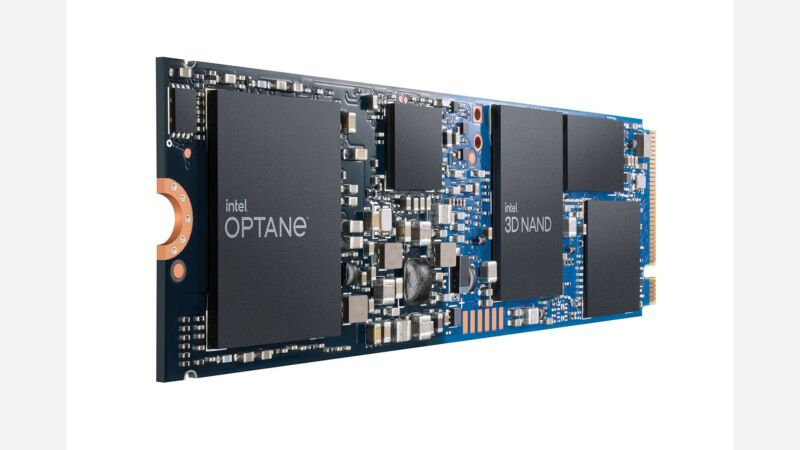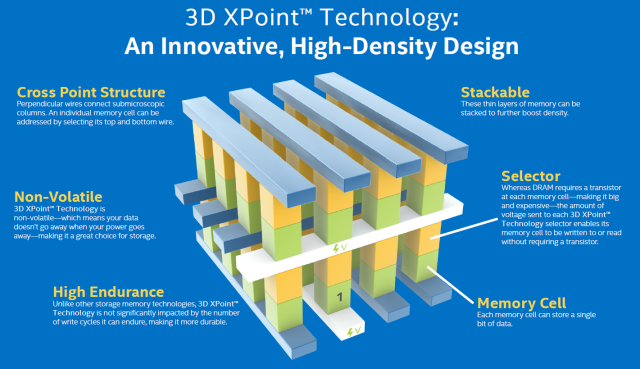
Intel has a new consumer-targeted storage product, called Optane H20—as in H twenty, not water. The new device is an M.2 2280 format drive, using QLC (Quad Level Cell) NAND storage running behind an Optane cache layer.
This isn't Intel's first try at an Optane-backed hybrid SSD—the first, 2019's Optane H10, made its way into a few consumer laptops but didn't make much of a splash. H20 is a second try, with a significantly improved QLC SSD and NAND controller.
What’s a QLC?
Conventional NAND SSDs store data by maintaining charge levels in individual cells aboard a solid-state medium. How much data each individual cell stores is configurable and has dramatic impact upon the cost, performance, and longevity of the NAND as a whole:
| Type | Bits per cell | Discrete voltage levels |
| SLC | 1 | 2 |
| MLC | 2 | 4 |
| TLC | 3 | 8 |
| QLC | 4 | 16 |
The simplest NAND storage type, single-level cell (SLC), is the highest performing—with only two discrete voltage levels to deal with ("on" and "off"), cells can be written to and read from with high speed and accuracy. It's also the most durable form of NAND formatting, since increasing "sloppiness" in charge levels as the cells become worn isn't much of a factor.
Unfortunately, with only a single bit stored per cell, SLC is quite expensive. If your only choice is between a tiny, expensive SLC SSD and a conventional hard drive, this can be tolerable—as Intel's original X-25M SSDs demonstrated—but once multi-level cell (MLC) drives hit the market, SLC rapidly retreated to the land of cache layers and cost-is-no-object enterprise storage.
Triple-level cell (TLC) storage is the current "sweet spot," with the vast majority of consumer-available SSDs in 2021 using this technology. Although slower than either SLC or MLC, with sufficient parallelization—meaning more "banks" of NAND in larger-capacity drives—TLC is more than fast enough for most consumer and even enterprise use cases.
That leaves us with quad-level cell (QLC) storage. You won't find any small-capacity QLC SSDs, because the individual NAND cells are slow—and not particularly long-lived, either. Reading from and writing to QLC NAND storage means needing to distinguish reliably between 16 discrete voltage levels—which is far slower on a per-cell basis and results in considerably fewer writes per cell before tolerances erode enough to degrade performance even further.
QLC is cheap, but it's not cheap enough to have become very popular yet. Mechanical hard drives are still far less expensive per TiB stored, and they lack QLC's longevity problems.
What’s an Optane?
Intel's marketing for Optane has always been confusing—the company tends to call it "persistent memory" rather than storage, but ultimately it's a different type of SSD. What Optane isn't is NAND technology at all—it doesn't fit into our "SLC, MLC, TLC, QLC" table above.

Conventional NAND-based SSDs work by storing charge—that is to say, a particular voltage level—in cells. Optane, instead, works by varying the resistance of its individual cells. The transistor-less technology results in nonvolatile storage with extremely high endurance and low latency. Optane isn't as fast as DRAM—your computer's actual memory—but it's significantly closer in performance than NAND can be.
Optane sits in a sort of no man's land between conventional SSDs and conventional RAM—it's more expensive and faster than NAND SSDs, but less expensive and slower than RAM.
Does a hybrid Optane/NAND SSD make sense?
Individually, both QLC and Optane are well understood. The more interesting question is whether marrying the two in a single device makes sense. Caching systems tend to be much more difficult to make effective than most consumers assume—recall the short-lived initial wave of enthusiasm for SSHDs, a class of mechanical hard drive with built-in NAND SSD cache. In real life, consumers quickly realized that the "amazing hybrid drive" didn't actually outperform regular HDDs in most cases, and its popularity plummeted in short order.
Intel's H20 banks on the same promise those early "SSHDs" made—the idea that it can present an inexpensive, large storage volume (QLC NAND, in this case) while offering performance levels associated with an enormously faster onboard cache (Optane). StorageReview did some very light benchmarking of the new drives with what look like excellent results—its 4K random reads at queue depth 1 are nearly triple what we recorded for the systems in our Gaming PC guide this year.
The devil, unfortunately, is in the details—StorageReview's limited benchmarking was done using CrystalDiskMark, with an overall data size of only 1GiB. This small test volume is well-sized to fit entirely inside the H20's 32GB onboard Optane cache, which will not be the case for many (if not most) typical consumer workloads.
Whether real-world use cases will be anywhere near as well-suited to the H20 as they are to this light benchmark will be interesting to see.
H20, H20 everywhere, with nary a drop to drink
Although the H20 becomes available on June 20, you won't be able to find one in your nearest PC store. The new drives are to be sold directly to Intel's OEM partners for inclusion in qualified systems with 11th-generation Intel CPUs.
Limiting distribution to OEM channel partners means we also don't know the exact price of the new 512GB and 1TB H20 drives—making it even more difficult to judge the H20's value proposition versus more traditional contenders, like the Samsung 980.
The Link LonkMay 19, 2021 at 01:35AM
https://ift.tt/33VnKwG
Intel’s Optane H20 is the latest attempt at “hybrid” laptop storage - Ars Technica
https://ift.tt/2YXg8Ic
Intel

No comments:
Post a Comment